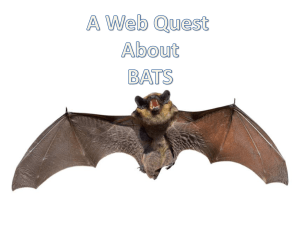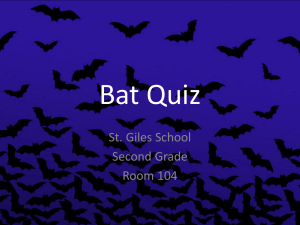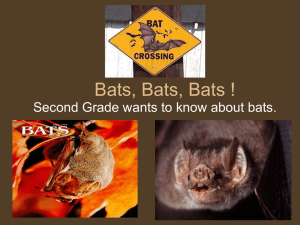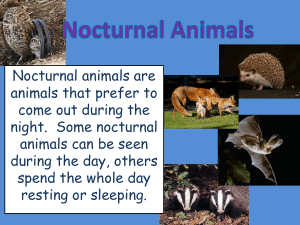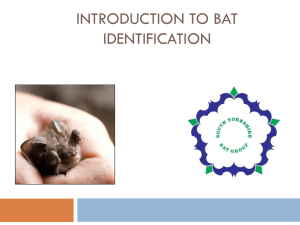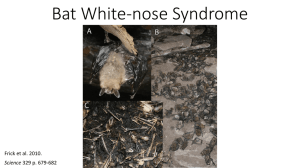INDIANA BATS - NAAE Communities of Practice
advertisement
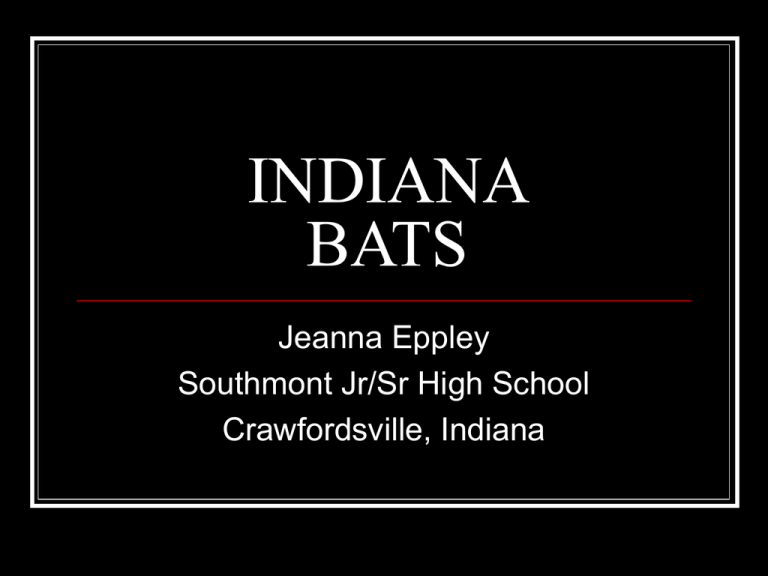
INDIANA BATS Jeanna Eppley Southmont Jr/Sr High School Crawfordsville, Indiana BATS Draw a picture, write words, phrases and/or sentences telling me What you know about bats How you feel about bats Experiences with bats Why are bats bad/good Etc… Why do we fear Bats? Bad Public Perception Vampires-Blood eaters Blind – “Blind as a bat” Diseases - Rabies Attacks – Biting people Is this true??? Are bats blind vampires? There are Vampire bats! They do NOT live in North America They do NOT feed on humans’ blood Bats are NOT blind, they do have eyes. There sight is not the best, but their hearing is! Will they drink my blood? No- Not in Indiana Only 3 species are blood eaters – Vampire Bats 680 species eat insects 236 species eat Fruit Others eat: meat (mostly rodents), nectar, and fish. Rabid Bats Attack??? Disease Bats, like most mammals, can transmit disease to other animals and humans. Sick bats do not live long and there are not many of them. Rabid Bats Attack??? Attack Bats will not fly at you! People who suffer from bat bites have put themselves in that situation. NEVER APPROACH AND/OR HANDLE A BAT and you will get along just fine. History and Folklore Have been worshiped as gods Symbols of good luck Associated with Halloween Bats are usually in hibernation at this time. Bat Facts Bats are Mammals Body is covered with Hair The mothers have Live Birth Usually 1 pup per year Mothers produce Milk for their young. Only True Flying Mammal About 1,000 Species Bats make up about ¼ of mammal species Indiana Bats Hoary Bat Silver-haired Bat Little Brown Myotis – Indiana Myotes Big Brown Bat Evening Bat Eastern Pipistrelle Big Brown Bat Common in Indiana and most of the US Average Weight: 20 grams Insectivores: Feed on Insects Favorite Food: Beetles and Moths Big Brown Bat Common in Indiana and most of the US Average Weight: 20 grams Insectivores: Feed on Insects Favorite Food: Beetles and Moths Photo Courtesy of Robert Chapman Purdue University Extension Big Brown Bat Photo Courtesy of Robert Chapman Purdue University Extension Little Brown Bat Common in Indiana and most of the US Insectivores: Feed on Insects Average Weight: 10 Grams Favorite Food: Aquatic Larva Photo Courtesy of Robert Chapman Purdue University Extension Eastern Pipestrelle Common in Indiana and Eastern half of U.S. Insectivores: Feed on Insects Average Weight: 5 Grams Favorite Food: Flying insects (Beetles, Moths, Flies) Eastern Pipestrelle Photo Courtesy of Robert Chapman Purdue University Extension Eastern Red Bat Common in Indiana and a majority of U.S. Insectivores: Feed on Insects Average Weight: 13 Grams Favorite Food: Flying insects (Beetles, Moths, Flies) Photo Courtesy of Robert Chapman Purdue University Extension Eastern Red Bat Photo Courtesy of Robert Chapman Purdue University Extension Importance to You How are bats important to your life? Brainstorm Japanese Beetles Cause major harm to our crops and landscape every year! Beetle Count Activity Worksheet – Japanese Beetle Populations Population Japanese Beetle Population: Each Female lays approximately __50____ eggs per year Life Cycle: _Complete: Egg, Larva, Pupae, Adult_________________ Damaging Stages ____Adult__ and ______Larvae________ Larval Stage Name _____White Grub_____________ Damages ___Larvae feed on roots below the ground; often the wounds left lead to disease transmission in the plant. Adults feed on foliage, very destructive. Use the following to determine the population increase for Japanese beetles. 1 Female x 50 Offspring = _____ x 50 cycle two = _____________ ___________x 50 cycle 3 = _______________ x 50 cycle 4 = _______________ ___________x 50 cycle 5 = _______________ x 50 cycle 6 = _______________ ___________x 50 cycle 7 = _______________ x 50 cycle 8 = _______________ ___________x 50 cycle 9 = _______________ x 50 cycle 10= _______________ If one bat can consume 1,000 insects per night, how many generations would the bat consume in one week? Show your work! Bat Habitat What must be provided for any organism to live Food Water Shelter What is the ideal bat habitat? Build your own Bat House! http://www.batcon.com/bhratop.html Reflection Write about three things you have learned about bats? Have your feelings about bats changed? What would you tell someone who is scared of bats to help them accept the mammals?
